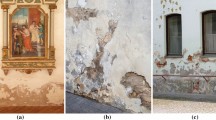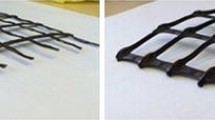Abstract
Following the destructive Bam earthquake of 2003, the Iranian government initiated a vast program of seismic retrofitting for existing school buildings throughout the country. As a result of the school retrofitting program, an extensive amount of field test data is available on the shear strength of brick walls of buildings from different parts of the country having different climates. A large portion of the available data is utilised in this paper to determine the effects of environmental conditions, particularly those of humidity and temperature, on the shear strength of brick walls. The effects of other factors including the type of material and age of the building are also investigated. Results of the statistical analyses highlight the important effects of the location humidity level. A nearly three folds increase in strength was noted for walls constructed of solid brick units in wetter northern parts of the country compared to those constructed in the drier central parts. Another important factor is found to be the absorption rate of bricks used in constructing the wall. On the other hand, the effect of overall environment temperature is found to be minimal. The daily temperature gradient of the location, however, may affect the strength by causing some long-term fatigue. It is recommended that for assessing the vulnerability of unreinforced brick walls, regionalization is considered and an appropriate ‘climate factor’ is adopted.















Similar content being viewed by others
References
Hendry AW, Sinha BP, Davies SR (1997) Design of masonry structures. Pub. E & FN Spon, London
Maheri MR, Najafgholipour MA, Rajabi A (2011) The influence of mortar head joints on the in-plane shear strength of unreinforced brick walls. Iran J Sci Technol 35(C1):63–79
Maheri MR, Motielahi F, Najafgholipour MA (2011) The effects of pre and post construction moisture condition on the in-plane and out-of-plane strength of brick walls. Mater Struct 44(2):541–559
Gooduin JF, West WH (1982) A review of the literature on brick/mortar bond. Proc Br Ceram Soc 30(23):23–37
Yorkdale AH (1982) In: Borchelt JG (ed) Initial rate of absorption and mortar bond. Masonry: materials, properties and performance, ASTM STP 778. American Society for Testing and Materials, pp 91–98
Lawrence SJ, Cao S (1994) The influence of some factors on the tensile bond strength of masonry. In: Shrive NG, Huizer, A (eds) Proceedings of the 10th international brick and block masonry conference (IB2 MaC), Calgary, Canada, pp 929–938
Sarangapani G, Venkatarama Reddy BV, Jagadish KS (2005) Brick-mortar bond and masonry compressive strength. J Mater Civ Eng 17(2):229–237
Ince C, Carter, MA, Wilson MA, El-Turki, A, Ball RJ, Allen GC, Collier NC (2009) Analysis of the abstraction of water from freshly mixed jointing mortars in masonry construction. Mater Struct 9560-5 (Published online)
Magenes G, Calvi GM (1997) In-Plane seismic response of brick masonry walls. Earthq Eng Struct Dyn 26:1091–1112
Gabor A, Ferrier E, Jacquelin E, Hamelin P (2006) Analysis and modeling of the in-plane shear behavior of hollow brick panels. Construct Build Mater 20(5):308–321
Tomazevic M (2009) Shear resistance of masonry walls and Eurocode 6: shear versus tensile strength of masonry. Mater Struct 42(7):889–907
Maheri MR, Naeim F, Mehrain M (2005) Performance of adobe residential buildings in the 2003 Bam, Iran, earthquake. Earthq Spectra 21(S1):S337–S344
Groot CJWP, Gunneweg J (2004) Water permeance problems in single wythe masonry walls: the case of wind mills. Construct Build Mater 18:325–329
Cultrone G, Sebastian E, Ortega Huertas M (2007) Durability of masonry systems: a laboratory study. Construct Build Mater 21:40–51
Terheiden K (2008) Simultaneous measurement of vapor and liquid moisture transport in porous building materials. Build Environ 43:2188–2192
Maheri MR (2005) Performance of building roofs in the 2003 Bam, Iran earthquake. Earthq Spectra 21(S1):S411–S424
Instruction for seismic rehabilitation of existing buildings, Pub. No. 360, Management and Planning Organization of Iran, 2007
ASTM C1531-09. Standard test methods for in situ measurement of masonry mortar joint shear strength index. 2009
MATLAB R2010a User’s guide Manual, Version 7.10.0.499, The Math Works Inc. 2010
Building and Housing Research Center, Iranian Code of Practice for Seismic Resistant Design of Buildings; Standard No 2800, Tehran, 2005
Maheri MR (2004) Seismic vulnerability of post Islamic monumental structures in Iran, a review of historical sources. ASCE J Archit Eng 10(4):160–166
ASTM E519-81, Standard Test Method for Diagonal Tension (Shear) in Masonry Assemblages, 1981, USA
Forth JP, Brooks JJ, Tapsir SH (2000) The effect of unit water absorption on long-term movements of masonry. Cem Concr Compos 22:273–280
Acknowledgments
The authors wish to acknowledge the help provided by the Schools Renovation, Development and Mobilization Organization of the Iranian Ministry of Education for making available the field test data used in this study.
Author information
Authors and Affiliations
Corresponding author
Rights and permissions
About this article
Cite this article
Maheri, M.R., Sherafati, M.A. The effects of humidity and other environmental parameters on the shear strength of brick walls: evaluation of field test data. Mater Struct 45, 941–956 (2012). https://doi.org/10.1617/s11527-011-9809-7
Received:
Accepted:
Published:
Issue Date:
DOI: https://doi.org/10.1617/s11527-011-9809-7




